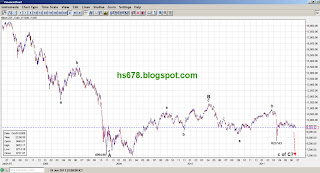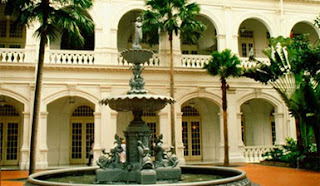by Venessa Wong
provided by
Bloomberg
Businessweek
Overall, global wealth grew fastest in the Asia Pacific region last year. North America came in second.
Singapore seems modest by some measures: Median income among working households was only about S$5,700 (about US$4,500) in 2010, according to the Singapore Department of Statistics. Yet in this small island nation of only 5 million, known for extravagant shopping, high-end restaurants, and draconian chewing-gum laws, nearly one in every six households has more than $1 million in assets, making it the densest population of wealthy households in the world, according to a new report by Boston Consulting Group.
As the financial markets improved last year, global wealth grew in nearly every region in the world. The fastest, at 17.1 percent, came in the Asia Pacific region (excluding Japan), followed by North America at 10.2 percent. "Global wealth is at an all-time high," says BCG Senior Partner Monish Kumar.
According to BCG's study, global assets under management grew 8 percent, to $121.8 trillion, about $20 trillion above the level during the depths of the global financial crisis. The number of millionaire households grew 12.2 percent, to 12.5 million, and although they represented only 0.9 percent of all households, they held 39 percent of global wealth.
Only Liquid AssetsBCG looked at 62 markets covering more than 98 percent of global GDP and measured assets that included cash deposits, money market funds, listed securities held directly or indirectly through managed investments, and onshore and offshore assets — but not wealth attributed to investors' own businesses, residences, or luxury goods.
Wealth in North America, the world's richest region, had the largest dollar-value gain: $3.6 trillion. The U.S. remains home to the most millionaire households — 5,220,000 (up 10.7 percent from 4,715,0000 households in 2009) — although the share was only 4.5 percent of all households, BCG data show.
While China and India are driving wealth creation in Asia, Singapore also grew at a fast pace. The number of millionaire households in Singapore jumped about 38.6 percent in 2010, to 170,000, from nearly 123,000 in 2009, according to BCG data. The country has had the largest proportion of millionaire households for several years, and the share continues to grow: Singapore's millionaire households increased to 15.5 percent of total households in 2010 from 11.4 percent in 2009.
The rise is due to Singapore's expanding economy, which has grown mainly on such exports as consumer electronics and pharmaceuticals, as well as financial services. Real GDP growth averaged 7.1 percent per year from 2004 to 2007, according to the
CIA World Factbook and reached nearly 14.7 percent in 2010—faster than China's 10.3 percent growth rate.
Not Just Tycoons
Among Singapore's well-known billionaires are Wee Cho Yaw, chairman of United Overseas Bank Group (Singapore:
UOB -
News), as well as the families of the late real estate mogul Ng Teng Fong and financier and hotelier Kho Teck Phuat. Still, many of the country's wealthy are not tycoons but entrepreneurs and affluent immigrants, says Tjun Tang, partner and managing director of BCG in Hong Kong. Other billionaires include philanthropist Richard Chandler in New Zealand and real estate developer Zhong Sheng Jian in China.
City-states such as Singapore, along with other small countries and administrative regions with a high density of millionaire households, such as Switzerland, Qatar, and Hong Kong, tend to be hubs of commerce and finance and have greater economic generation within a smaller population, says Tang.
Another factor driving wealth: Singapore's investor scheme, which grants permanent residence to certain investors, says Tang. According to the
website of Janus Corporate Solutions, people can "invest [their] way to Singapore permanent residence" by investing more than a certain minimum in a new business startup or Global Investor Program-approved fund or in expanding an existing business in Singapore.
More Money, But Higher Costs
With this wealthy population comes a relatively high cost of living. In a 2010 cost-of-living
survey of 214 cities by consulting firm Mercer, Singapore is the 11th most expensive city in the world for expatriates, on a par with Oslo and more expensive than New York City.
Mercer also gave Singapore high scores in its 2010 quality-of-life
study of 221 cities: It was the top-scoring Asian city, followed by Tokyo.
The economic trends remain a concern around the world, yet BCG expects that with strong capital markets, GDP growth, and increased savings, global wealth will grow at a compound annual growth rate of 5.9 percent through 2015. Singapore has already led with the highest proportion of millionaire households for several years. With the Asia-Pacific region's share of global wealth expected to increase to 23 percent in 2015, from 18 percent in 2010, Tang says, "the trends seem to be in Singapore's favor."
Here are the countries with the highest proportion of millionaires:
No. 1: Singapore
Millionaire households as a share of country's total households: 15.5%
Number of millionaire households: 170,000
2009 ranking: 1
Singapore is home to the world's greatest concentration of millionaire households. Deloitte expects that by 2015, it may surpass Switzerland in per capita wealth among millionaire households. Singapore is Asia's eighth-most-expensive location, according to
ECA International.
No. 2: Switzerland
Millionaire households as a share of country's total households: 9.9%
Number of millionaire households: 330,000
2009 ranking: 3
With nearly one in 10 households in Switzerland a millionaire household, the country is one of the world's most expensive. Residents of Geneva and Zurich pay about 20 percent more on average for products, services, and accommodation than do people in other Western European cities, according to a UBS study. Food prices in particular are high — about 45 percent above levels in the rest of Western Europe.
No. 3: Qatar
Millionaire households as a share of country's total households: 8.9%
Number of millionaire households: 30,000
2009 ranking: 2
Qatar is the world's fastest-growing economy, as well as one of the richest: Annual GDP growth is estimated at 19.4 percent in 2010, with per capita GDP at $145,300, according to the
CIA's World Factbook. The country has the world's third-largest reserves of natural gas, with oil and gas accounting for more than half of GDP, 85 percent of export earnings, and 70 percent of government revenues.
No. 4: Hong Kong
Millionaire households as a share of country's total households: 8.6%
Number of millionaire households: 200,000
2009 ranking: 4
In the past decade, Hong Kong's manufacturing industry moved to mainland China and its service industry grew to more than 90 percent of GDP. While Hong Kong's GDP fell in 2009 as a result of the global financial crisis, recovery began in the third quarter of 2009 and in 2010 the economy grew by nearly 6.8 percent, according to the
CIA's World Factbook. The housing market also continues to grow tremendously: In 2010 Q4, home prices were up 20.1 percent year-on-year, according to Knight Frank.
No. 5: Kuwait
Millionaire households as a share of country's total households: 8.5%
Number of millionaire households: 40,000
2009 ranking: 5
Petroleum accounts for nearly half Kuwait's GDP, 95 percent of export revenues, and 95 percent of government income, according to the
CIA's World Factbook. The rise in global oil prices has boosted government budget revenue and revived government consumption and economic growth.
No. 6: United Arab Emirates
Millionaire households as a share of country's total households: 5%
Number of millionaire households: 50,000
2009 ranking: 6
Since oil was discovered in the U.A.E. more than 30 years ago, the country has transformed itself from an impoverished region to a modern state with a high standard of living, high per capita income, and a sizable annual trade surplus, according to the
CIA's World Factbook. Oil and gas output represents about 25 percent of GDP.
No. 7: United States
Millionaire households as a share of country's total households: 4.5%
Number of millionaire households: 5,220,000
2009 ranking: 7
After declining in 2008, the U.S. millionaire population grew in 2009 and continued to rebound in 2010, according to BCG. While the economy has shown only slight improvement, the U.S. still has by far the most millionaire households of any country, as well as the largest number of ultra-high-net-worth households (those with more than $100 million in assets under management).
No. 8: Taiwan
Millionaire households as a share of country's total households: 3.6%
Number of millionaire households: 280,000
2009 ranking: 8
Taiwan has a widening wealth gap: In 2009, the top quintile of income earners made 6.34 times as much as the bottom quintile, up from 5.5 times 10 years ago, according to the Directorate General of Budget, Accounting, and Statistics. The government recently considered passing a luxury tax on: non-owner occupied homes sold within two years of purchase; automobiles, yachts, helicopters, and airplanes that cost more than TWD3 million (about $104,700); and ivory, coral, furs, and furniture worth more than TWD500,000 (about $17,400), reported the
Christian Science Monitor.
No. 9: Israel
Millionaire households as a share of country's total households: 3.4%
Number of millionaire households: 80,000
2009 ranking: 10
The share of millionaire households remains high in Israel, which has shown signs of economic recovery. Following growth of 4 percent in 2008, Israel's GDP slipped by 0.2 percent in 2009, then rose by 3.4 percent in 2010 as exports rebounded, according to the CIA's World Factbook. Home prices in Israel were up year-on-year during each quarter in 2010, show data from Knight Frank.
No. 10: Belgium
Millionaire households as a share of country's total households: 3.1%
Number of millionaire households: 140,000
2009 ranking: 9
Belgium has the greatest concentration of millionaires among EU member countries. Residents do not pay a wealth tax, but are subject to personal income tax, as well as withholding tax, social security, inheritance and gift tax, and communal taxes, according to Deloitte Touche Tohmatsu.
Wong is a lifestyle and real estate reporter for Bloomberg Businessweek.
Click here to see the full list of Countries With the Highest Proportion of Millionaires.
Source: http://finance.yahoo.com/real-estate/article/112859/millionaires-world-singapore-businessweek


































